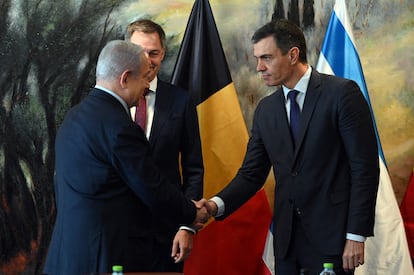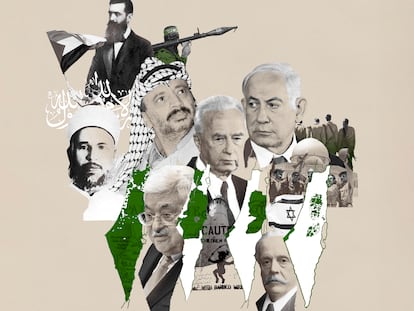The two-state solution returns to the table as a political route to end Israel-Palestine conflict
The idea of two states coexisting side by side remains a reference point but its implementation is hampered by the realities on the ground. ‘Everything is reversible,’ says one expert


Only a wandering, starving dog managed to cross the Qalandia checkpoint on Tuesday without waiting two hours in line at the nine-meter-high concrete Israeli wall that, like a wound, separates East Jerusalem from the land that surrounds it: the West Bank. When September 13 marked three decades since the Oslo peace accords those two pieces of Palestine — which were to be the capital and part of the territory of a Palestinian state — had been torn apart for years by the wall. Today it is Israel, which the United Nations terms the “occupying power” in Gaza, the West Bank and East Jerusalem, that decides whether a Palestinian can cross at Qalandia to travel through the land of their ancestors. Before Hamas attacked Israel on October 7, and Israel responded by unleashing its war in Gaza, the two-state solution, which was believed to have been enshrined in Oslo, was gathering dust in the drawer of forgotten causes. However, in the context of the current conflict, the political path to establishing a Palestinian state alongside Israel is now back on the table.
On October 25, U.S. President Joe Biden advocated the two-state solution and he has repeatedly referred to it since, most recently last Saturday in The Washington Post. On October 27, the European Council endorsed a proposal from Spanish Prime Minister Pedro Sánchez for an international conference to seek peace between Israel and Palestine based on that formula. Even Pope Francis has joined the chorus, repeating an idea in which some however view a smokescreen to mask “the dispossession of the Palestinian people,” as defined by the former director of the New York office of the UN high commissioner for human rights, Craig Mokhiber, who resigned in October because of the “failure” of the UN to prevent a “text book case of genocide” in Gaza.
In Ramallah, the capital of the West Bank, a Palestine Liberation Organization (PLO) official who requested anonymity repeats another of Mokhiber’s arguments: that the United States and Europe are “complicit” in Israel’s war in the Strip and at the same time reviving the two-state solution - the application of which they have never imposed on Israel. Sánchez on Thursday advocated a “viable” Palestinian state during a meeting with Israeli President Isaac Herzog in Jerusalem, but the PLO official points out “the easiest thing Spain [which holds the rotating presidency of the European Union] can do to move towards that goal is to recognize the Palestinian state.”
The Palestinian official also notes that neither Biden nor any of the other leaders who now point to the two-state path have referred to what in his opinion is the “indispensable condition” for a viable Palestinian State: “The end of the Israeli occupation.”

The Israel-Palestine conflict
The history of the struggle between Israel and the Palestinian people has since 1948 featured a constant that Edward Said once defined as “the monotonous undercurrent of land alienation” by the former. That state, said the Palestinian philosopher, is the fruit of a “basically European ideology,” Zionism, a movement that for decades defined itself as colonialist. In 1947, a year before the creation of the State of Israel, the United Nations adopted a plan for the partition of the British mandate of Palestine into two states that was “manifestly unjust,” says the PLO official. In the partition, 70% of the indigenous Arab population was granted only 45% of the land, while 30% of the Jewish population was granted 55%, a distribution that the Arab countries rejected, thus triggering the first Arab-Israeli war in 1948, in the aftermath of which Israel took over 77% of the territory. In 1967, after the Six-Day War, Israel occupied the remainder of the lands allocated to the Palestinian people by the United Nations.
In signing the Oslo Accords of 1993-1995, the PLO settled for negotiating only 22% of that territory for the Palestinian state; the pre-1967 borders. In exchange, Israel accepted the establishment of an interim autonomous administration in Gaza and the West Bank, managed by the Palestinian National Authority (PNA), which was to last for five years but still exists in the West Bank. Gaza has been in the hands of Hamas since 2007. The PNA only acceded to partial control of two of the territory’s three areas, A and B. The rest, 60% of its land total, is Area C, which remains under Israeli control, despite the fact that the Oslo agreement provided for its handover to the Palestinian authorities.
In the three decades since the signing of this framework, the “reality of Israel’s faits accompli on the ground” shows that the Oslo Accords, far from leading to a Palestinian state, “have served for Israel to legitimize itself, covering up its occupation; a colonization that has reached stratospheric levels,” says Isaías Barreñada, professor of international relations at the Complutense University of Madrid.
The main instrument of this policy to blur the two-state solution has been illegal settlements in East Jerusalem and in the area of the West Bank that Israel controls completely. In 1993, when the first Oslo agreement was signed, these settlers numbered around 130,000. Today, according to the UN, there are almost 700,000. A plan frozen by Benjamin Netanyahu’s government in July 2020 envisages incorporating these settlements and the roads built for them into Israeli territory — Palestinians are forbidden to drive on them — thus annexing at least 30% of the West Bank.
Ignacio Álvarez-Ossorio, professor of Arab and Islamic studies at the Complutense University, points out that a future Palestinian state would not only have no “physical space” but also no “territorial continuity,” in reference to the fact that the two areas under Palestinian authority are not contiguous. They resemble islets surrounded by the area under full Israeli control. The PNA also lacks several of the fundamental attributes of a state: control of the territory and its population, well-defined borders, and a monopoly on the use of force, which remains in the hands of Israel.
To this reality, other obstacles to the two-state solution have now been added. Barreñada cites two. The first is that the “extreme violence with which Israel is acting in Gaza” ruins “any chance of the parties sitting down together for the next 50 years.” The second is that, “the willingness of the parties to negotiate” after the war being “ruled out,” the only alternative would be “[the same thing] as happened in Oslo; the United States forcing Israel into dialogue”.
Barreñada says this is a “remote” possibility, pointing out that between 1972 and October 2023, Washington has used its veto power in the UN Security Council “on 34 occasions” to avoid condemning Israel for its occupation of Palestine. Sánchez’s proposal for a Middle East peace conference is “naïve,” adds the expert, who sees only one possible solution to the conflict: an end to the “international impunity enjoyed by Israel.”
“Moderates on both sides”
Nadav Tamir, head of international affairs at the Peres Center for Peace and Innovation in Tel Aviv, is more optimistic. “What October 7 showed us all is that you can’t keep the conflict going, that it needs to be resolved.” Tamir is confident that “moderates on both sides” will reach a new agreement and that one of the conditions for this is “a change of government in Israel, which is definitely going to happen after this huge failure, and Palestinian elections in which a legitimate leader is elected for both Gaza and the West Bank.”
The PLO official disagrees: “Israel has never recognized the two-state solution or the rights of the Palestinian people. It is as simple as asking an Israeli official if they believe in two states: they can say whatever they want, but the official policy is that there are not two states, there is only one: Israel. If you don’t want two independent states and you don’t want a democratic state for all, what choice is left? Either genocide, like what is happening now in Gaza, or what Amnesty International and Human Rights Watch have denounced: apartheid.”
Barreñada clarifies that, despite the difficulties, the “idea of the two states is still a reference point but it has lost relevance because it is perceived as increasingly difficult.” However, he stresses that “a state of their own is an inalienable right of the Palestinians, as enshrined in UN Resolution 3236 of 1974.” The conditions on the ground, which make it hardly viable, “can change,” he notes, concluding: “Everything is reversible.”
Sign up for our weekly newsletter to get more English-language news coverage from EL PAÍS USA Edition
Tu suscripción se está usando en otro dispositivo
¿Quieres añadir otro usuario a tu suscripción?
Si continúas leyendo en este dispositivo, no se podrá leer en el otro.
FlechaTu suscripción se está usando en otro dispositivo y solo puedes acceder a EL PAÍS desde un dispositivo a la vez.
Si quieres compartir tu cuenta, cambia tu suscripción a la modalidad Premium, así podrás añadir otro usuario. Cada uno accederá con su propia cuenta de email, lo que os permitirá personalizar vuestra experiencia en EL PAÍS.
¿Tienes una suscripción de empresa? Accede aquí para contratar más cuentas.
En el caso de no saber quién está usando tu cuenta, te recomendamos cambiar tu contraseña aquí.
Si decides continuar compartiendo tu cuenta, este mensaje se mostrará en tu dispositivo y en el de la otra persona que está usando tu cuenta de forma indefinida, afectando a tu experiencia de lectura. Puedes consultar aquí los términos y condiciones de la suscripción digital.
More information
Archived In
Últimas noticias
Most viewed
- Reinhard Genzel, Nobel laureate in physics: ‘One-minute videos will never give you the truth’
- Oona Chaplin: ‘I told James Cameron that I was living in a treehouse and starting a permaculture project with a friend’
- Pablo Escobar’s hippos: A serious environmental problem, 40 years on
- Why we lost the habit of sleeping in two segments and how that changed our sense of time
- Chevy Chase, the beloved comedian who was a monster off camera: ‘Not everyone hated him, just the people who’ve worked with him’










































